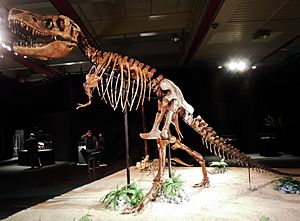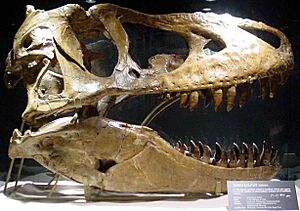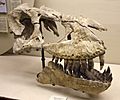Tarbosaurus facts for kids
Quick facts for kids Tarbosaurus |
|
|---|---|
 |
|
| Skeleton on exhibit in Dinosaurium, Prague | |
| Scientific classification | |
| Synonyms | |
|
Genus synonymy
Shanshanosaurus
(Dong, 1977) Maleevosaurus (Carpenter, 1992) Jenghizkhan (Olshevsky, 1995) ?Raptorex (Sereno et al., 2009) Species synonymy
Tyrannosaurus bataar
Maleev, 1955 Gorgosaurus novojilovi Maleev, 1955 Tarbosaurus efremovi Maleev, 1955 Gorgosaurus lancinator Maleev, 1955 Deinodon novojilovi (Maleev, 1955) Deinodon lancinator (Maleev, 1955) Aublysodon lancinator (Maleev, 1955) Charig, 1967 Aublysodon novojilovi (Maleev, 1955) Charig, 1967 Shanshanosaurus huoyanshanensis Dong, 1977 Tyrannosaurus efremovi (Maleev, 1955) Tarbosaurus novojilovi (Maleev, 1955) Aublysodon huoyanshanensis (Dong, 1977) Albertosaurus novojilovi (Maleev, 1955) Maleevosaurus novojilovi (Maleev, 1955) Jenghizkhan bataar (Maleev, 1955) Tyrannosaurus novojilovi (Maleev, 1955) ?Raptorex kriegsteini (Sereno et al., 2009) |
Tarbosaurus was a huge meat-eating dinosaur that lived in Asia. You can find its fossils mostly in Mongolia and China. It was a type of dinosaur called a theropod, known for walking on two legs.
This mighty dinosaur lived about 70 to 65 million years ago. This was at the very end of the Cretaceous period, just before dinosaurs disappeared. Tarbosaurus was a top predator in its environment. It probably hunted other large dinosaurs. These included plant-eaters like the duck-billed Saurolophus and the long-necked Nemegtosaurus.
Scientists have found many Tarbosaurus fossils. These include several complete skulls and skeletons. These amazing finds have helped experts learn a lot. They have studied its family tree, how its skull worked, and even its brain structure.
Contents
How Tarbosaurus Compares to T. rex
Tarbosaurus was a close relative of the famous Tyrannosaurus rex from North America. They shared many features, but also had some key differences.
What Was Its Skull Like?
Like T. rex, Tarbosaurus had a very large head and strong jaws. But its huge skull was surprisingly light. It had big air pockets inside, which made it strong without being too heavy. Many of its bones were hollow, making them light but still very tough. This helped the large predator move easily.
The Tarbosaurus skull was similar to Tyrannosaurus. However, it was more rigid, meaning it was less flexible. Also, its skull was not as wide at the back. This meant Tarbosaurus likely didn't have the same kind of binocular vision as Tyrannosaurus. Binocular vision helps animals see depth.
In its lower jaw, Tarbosaurus had a special feature. A ridge on the outside of one bone (the angular bone) connected with the back of another bone (the dentary bone). This created a unique locking system in its jaw. Other tyrannosaurids had more flexible lower jaws.
What Were Its Limbs Like?
Tarbosaurus had small front limbs, or arms, with only two fingers. This short, two-fingered arm is a special feature of all tyrannosaurid dinosaurs.
Its back legs were long and thick. They supported its body as it walked on two feet. Its long, heavy tail helped balance its head and body. It acted like a counterweight, keeping the dinosaur's center of gravity over its hips.
How Tarbosaurus Lived
Some scientists believe the strong, rigid skull of Tarbosaurus was a special adaptation. It might have helped it hunt the very large, long-necked dinosaurs (called sauropods) found in Asia. These huge sauropods were not common in North America during the late Cretaceous period.
Scientists think that both Asian and North American tyrannosaurs were skilled hunters. They also probably ate dead animals when they found them. But the types of prey they hunted were different. For example, adult T. rex likely hunted large horned dinosaurs like Triceratops. These dinosaurs were not found outside North America.
Because of this, Tarbosaurus in Mongolia had to hunt sauropods. These differences in what they ate might have led to different hunting styles. This could explain why their skulls and bodies developed in slightly different ways.
Images for kids
-
Holotype skull PIN 551-1, Museum of Paleontology, Moscow
-
Tarbosaurus fossils that were smuggled to the US, and subsequently returned to Mongolia, at New York
-
Cretaceous-aged dinosaur fossil localities of Mongolia; Tarbosaurus was collected in area A (left)










